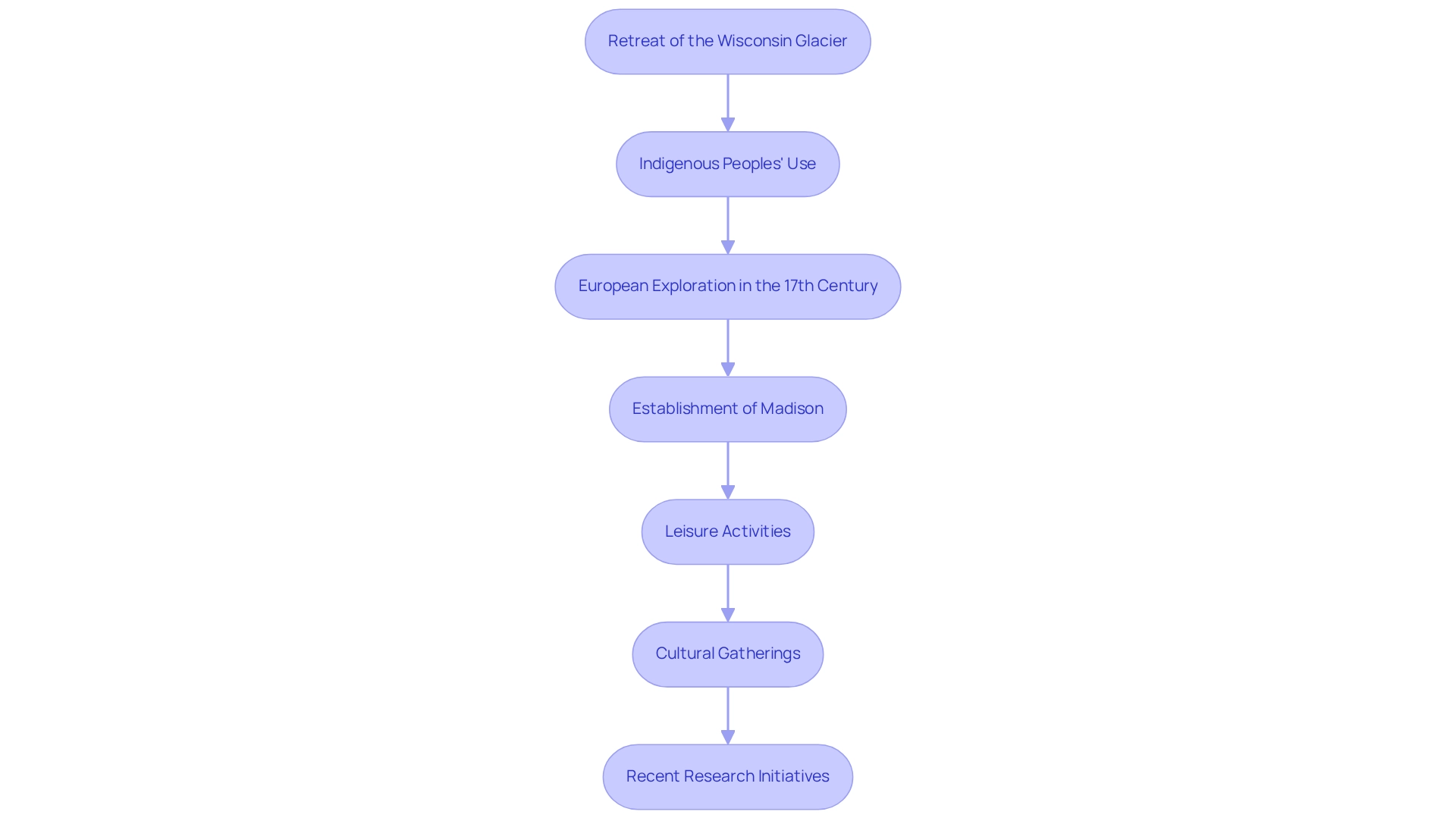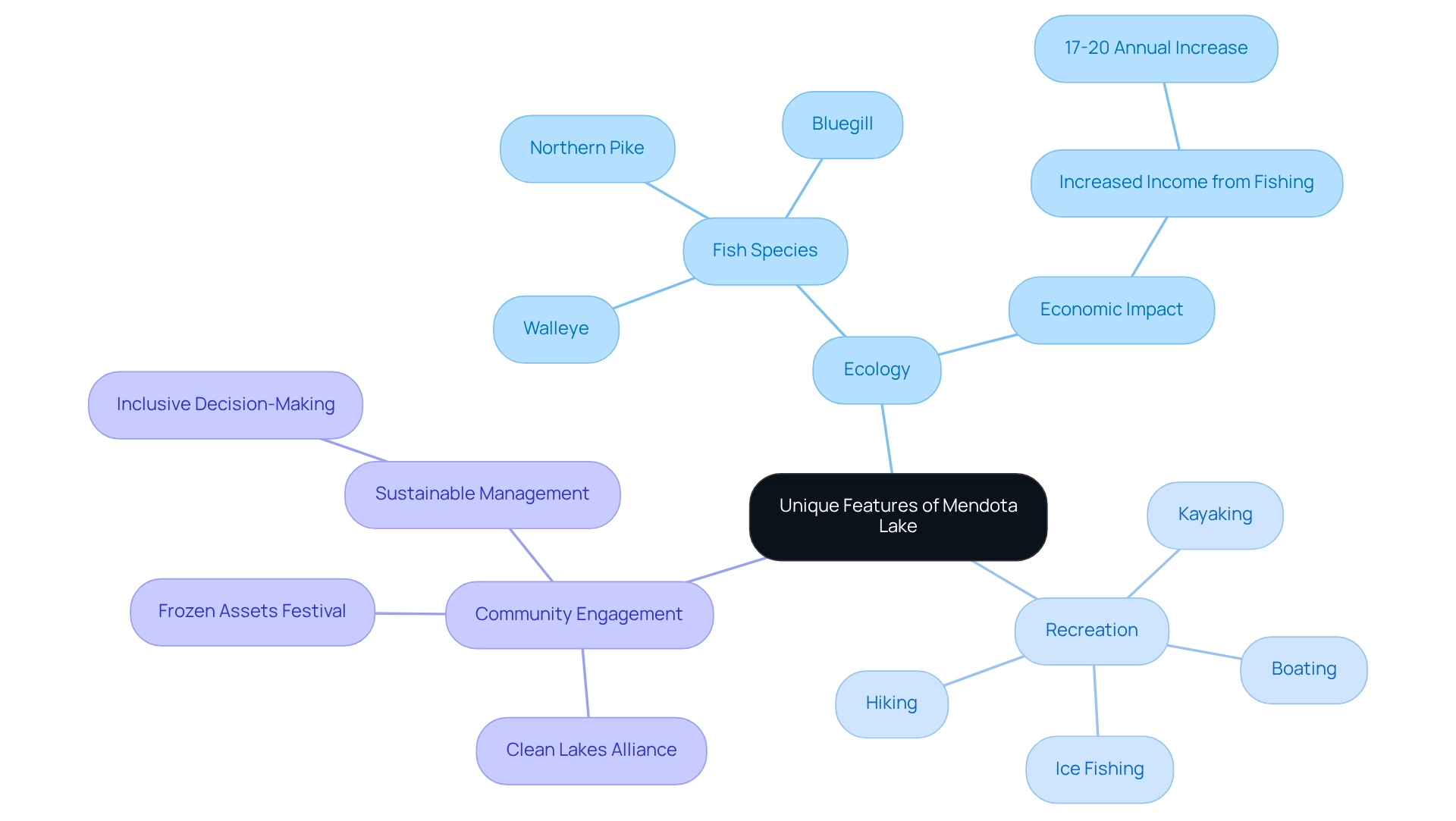Overview
Mendota Lake stands out as a vital resource, celebrated for its ecological diversity, recreational opportunities, and cultural significance within the Madison community. Its role in supporting various species is crucial, fostering a rich ecosystem that invites community engagement in conservation efforts. Furthermore, the lake serves as a hub for recreational activities, reinforcing its value not only for the environment but also for the local identity. This multifaceted importance underscores the lake's integral role in enhancing both ecological health and community spirit.
Introduction
Mendota Lake, a stunning natural gem nestled in Madison, Wisconsin, transcends the definition of a picturesque body of water. Spanning approximately 5,400 acres, this freshwater eutrophic lake plays a pivotal role in the region's ecology and community life. Its shores, lined with parks and the vibrant University of Wisconsin-Madison campus, serve as a hub for recreational activities and cultural events.
Yet, beneath its serene surface lies a complex interplay of ecological challenges and community efforts aimed at preserving its health. From the rich history of Indigenous peoples to contemporary conservation initiatives, Mendota Lake embodies a unique narrative that reflects the deep connection between nature and the local populace.
As the lake confronts pressing environmental threats, the call for community engagement and sustainable practices has never been more crucial, establishing it as a focal point for both ecological stewardship and cultural heritage.
Defining Mendota Lake: An Overview of Its Geographic and Ecological Significance
The body of water located in Madison, Wisconsin, stands as the northernmost and largest of the four bodies of water in the Yahara chain, spanning approximately 5,400 acres with a maximum depth of 83 feet. Designated as a freshwater eutrophic body of water, it is characterized by elevated nutrient levels that foster a diverse array of aquatic life. The shores of Mendota Lake are enhanced by parks, residential neighborhoods, and the University of Wisconsin-Madison campus, establishing this water body as a pivotal feature of the community.
Ecologically, Lake Mendota plays a vital role in supporting various species of fish, birds, and wildlife, thereby contributing to the region's biodiversity. Recent initiatives, such as the construction of a $1.6 million nutrient concentration system at the Middleton digester, underscore community efforts to manage nutrient levels and improve water quality in light of its eutrophic classification. Furthermore, the removal of invasive plant species from 17 acres of the UW-Madison Lakeshore Nature Preserve and the planting of native seeds on 11 acres highlight ongoing efforts aimed at enhancing the ecological health of this water body. Community involvement is further emphasized through regional organizations focused on water quality, which are instrumental in preserving the health of the water body.
The Friends of Pheasant Branch Conservancy have been actively engaged in evaluating carp barrier systems and maintaining natural areas, which are essential for improving water quality and revitalizing adjacent ecosystems. Their efforts directly support the overall health of the watershed surrounding Mendota Lake, reinforcing the critical role of community engagement in ecological restoration. The geographic significance of Mendota Lake is further highlighted by its function in recreational activities, attracting residents and visitors for fishing, boating, and nature observation. As a crucial resource, this body of water not only sustains local wildlife but also enriches the community's cultural and recreational landscape, solidifying its status as an essential component of Madison's identity.
Tracing the History of Mendota Lake: Key Events and Cultural Impact
The body of water presents a remarkable history that spans over 10,000 years, intricately shaped by the retreat of the Wisconsin Glacier. This natural wonder has served as a vital resource for Indigenous peoples, particularly the Ho-Chunk Nation, who have called this region home for centuries. European exploration commenced in the 17th century, with fur traders and missionaries documenting the area's rich resources, which played a pivotal role in the region's development.
Significant milestones have defined its history, notably the establishment of Madison in the 19th century, which transformed the area into a dynamic urban center. Leisure activities have flourished around Mendota Lake, solidifying its status as a beloved community destination. The cultural influence of Mendota Lake is profound; it has acted as a gathering place for community events, festivals, and educational programs, fostering a deep connection between Mendota Lake and the local populace. Recent initiatives, such as ground penetrating radar studies conducted in collaboration with the Bad River Band of Lake Superior Chippewa, aim to uncover the historical significance of this body further. These studies focus on ancient canoes concealed within the water, with plans to exhibit two canoes at the Wisconsin History Center in 2027, while others remain submerged due to their delicate condition. This ongoing research underscores the cultural legacy of Mendota Lake and its significance to Indigenous populations. Furthermore, a comprehensive literature review has unveiled 1,711 peer-reviewed publications on wetland ecosystem services, underscoring the ecological significance of bodies of water like this one and their role in sustaining diverse ecosystems. Ultimately, this body of water stands as a testament to the intertwined histories of the land and its inhabitants, reflecting the enduring legacy of Indigenous cultures and its influence in shaping community identity and events.

Unique Features of Mendota Lake: Ecology, Recreation, and Community Engagement
Mendota Lake is distinguished by its rich ecological diversity, which includes a variety of fish species such as walleye, northern pike, and bluegill, significantly contributing to its popularity among anglers. Notably, the per capita income of fishers in the region has increased by 17-20% annually due to bio-rights intervention, underscoring the economic importance of the fishing community.
The surrounding parks offer a multitude of recreational activities, including:
- Boating
- Kayaking
- Ice fishing
- Hiking
These activities attract both locals and visitors throughout the year. Community involvement is pivotal in the stewardship of this body of water, with organizations like the Clean Lakes Alliance spearheading conservation efforts and educational programs that engage marginalized communities in decision-making processes related to wetland preservation.
Events such as the Frozen Assets Festival not only celebrate winter activities but also raise awareness about the lake's health, fostering a robust sense of community among residents. Recent news has underscored the significance of sustainable management strategies for ecosystem services, further illustrating the ongoing efforts to safeguard this vital resource.
The distinctive combination of ecological abundance and recreational options establishes Mendota Lake as a valued asset for the Madison region, enhancing both its ecological and community worth.

Environmental Challenges Facing Mendota Lake: A Call for Conservation
Mendota Lake is distinguished not only for its natural beauty and ecological significance but also as a location facing critical environmental challenges. Nutrient pollution, primarily stemming from urban and agricultural runoff, leads to eutrophication, resulting in harmful algal blooms that threaten aquatic life and water quality. Alarmingly, statistics reveal that nutrient pollution is a pressing concern for many freshwater bodies, with studies indicating that over 50% of these areas in the U.S. are affected by this issue. Additionally, invasive species, such as zebra mussels, pose a formidable threat by disrupting local ecosystems and outcompeting native species for essential resources.
To address these challenges, robust conservation efforts are imperative. Initiatives focused on reducing runoff, restoring habitats, and promoting sustainable practices are currently underway, yet they necessitate active community involvement. As Richard Rogers aptly stated, "The only way forward, if we are going to improve the quality of the environment, is to get everybody involved." Local residents and businesses can play a pivotal role in enhancing the lake's health by engaging in conservation programs and advocating for environmentally friendly practices. Furthermore, as former UN Secretary-General Kofi Annan cautioned, the world is approaching a tipping point regarding climate change, underscoring the urgency for immediate action to secure a sustainable environment for future generations. By engaging the community, we not only cultivate a sense of stewardship but also amplify the effectiveness of conservation efforts, ensuring that the resource of Mendota Lake remains vital for years to come. Corporate gifting managers have a unique opportunity to support these initiatives, thereby contributing significantly to the preservation of this essential ecosystem.
Conclusion
Mendota Lake stands as more than a picturesque landmark in Madison; it is an essential ecological and cultural asset that has influenced the local community for millennia. The lake's geographic significance, paired with its rich biodiversity, highlights the critical need for ongoing conservation efforts to safeguard its vitality. Community engagement is paramount, with local organizations diligently addressing environmental challenges such as nutrient pollution and invasive species. These initiatives not only preserve the lake's ecosystems but also cultivate a profound sense of connection among residents.
The historical and cultural narratives intertwined with Mendota Lake further accentuate its significance. From Indigenous communities to contemporary recreational pursuits, the lake has served as a communal hub that mirrors the shared histories of the land and its inhabitants. As research continues to unveil its past, the lake remains a pivotal point for cultural heritage and ecological education.
Ultimately, the future of Mendota Lake relies on unified action and sustainable practices. The urgency for community involvement in conservation has never been greater, as the lake confronts threats that could compromise its ecological integrity. By prioritizing stewardship and endorsing local initiatives, the community can ensure that Mendota Lake remains a treasured resource for generations to come, exemplifying the delicate equilibrium between nature and human activity.
Frequently Asked Questions
What is Lake Mendota and where is it located?
Lake Mendota is the northernmost and largest of the four bodies of water in the Yahara chain, located in Madison, Wisconsin. It spans approximately 5,400 acres and has a maximum depth of 83 feet.
What type of body of water is Lake Mendota classified as?
Lake Mendota is classified as a freshwater eutrophic body of water, characterized by elevated nutrient levels that support a diverse array of aquatic life.
What are some key features surrounding Lake Mendota?
The shores of Lake Mendota are enhanced by parks, residential neighborhoods, and the University of Wisconsin-Madison campus, making it a pivotal feature of the community.
How does Lake Mendota contribute to local biodiversity?
Lake Mendota plays a vital role in supporting various species of fish, birds, and wildlife, thus contributing to the region's biodiversity.
What initiatives are being undertaken to improve Lake Mendota's water quality?
Recent initiatives include the construction of a $1.6 million nutrient concentration system at the Middleton digester, removal of invasive plant species from 17 acres of the UW-Madison Lakeshore Nature Preserve, and planting of native seeds on 11 acres.
How is the community involved in the preservation of Lake Mendota?
Community involvement is emphasized through regional organizations focused on water quality, such as the Friends of Pheasant Branch Conservancy, which evaluate carp barrier systems and maintain natural areas to improve water quality.
What recreational activities does Lake Mendota support?
Lake Mendota attracts residents and visitors for various recreational activities, including fishing, boating, and nature observation.
Why is Lake Mendota considered an essential component of Madison's identity?
Lake Mendota sustains local wildlife and enriches the community's cultural and recreational landscape, solidifying its status as a crucial resource in Madison.



